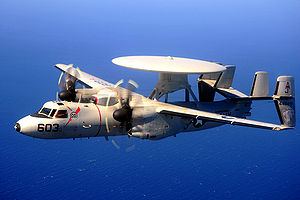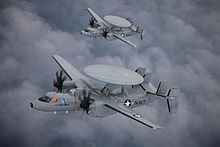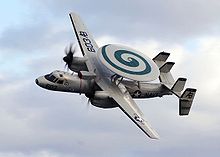- Northrop Grumman E-2 Hawkeye
-
E-2 Hawkeye A US Navy E-2C Hawkeye Role Airborne early warning and control Manufacturer Grumman
Northrop GrummanFirst flight 1960 Introduction January 1964 Status Active service Primary users United States Navy
(See operators)Unit cost US$80 million Variants C-2 Greyhound The Grumman E-2 Hawkeye is an American all-weather, aircraft carrier-capable tactical airborne early warning (AEW) aircraft. This twin-turboprop aircraft was designed and developed during the late 1950s and early 1960s by the Grumman Aircraft Company for the United States Navy as a replacement for the earlier E-1 Tracer, which was rapidly becoming obsolete. E-2 performance has been upgraded with the E-2B, and E-2C versions, where most of the changes were made to the radar and radio communications due to advances in electronic integrated circuits and other electronics. The fourth version of the Hawkeye is the E-2D, which first flew in 2007.
The E-2 also received the nickname "Super Fudd"[1] because it replaced the E-1 Tracer "Willy Fudd". In recent decades, the E-2 has been commonly referred to as the "Hummer" because of the distinctive sounds of its turboprop engines, quite unlike that of turbojet and turbofan jet engines. The E-2 and its sister, the C-2 Greyhound, are currently the only propeller airplanes that operate from aircraft carriers. In addition to U.S. Navy service, smaller numbers of E-2s have been sold to the armed forces of Egypt, France, Israel, Japan, Mexico, Singapore and Taiwan.
Contents
Development
Background
Continual improvements in airborne radars up through 1956 led to the construction of AEW airplanes by several different countries and several different armed forces. The functions of command and control and sea & air surveillance were also added. The first carrier-based aircraft to perform these missions for the U.S. Navy and its allies was the Douglas AD Skyraider, which was replaced in US Navy service by the Grumman E-1 Tracer, which was a modified version of the S-2 Tracker twin-engine anti-submarine warfare aircraft, where the radar was carried in an aerofoil-shaped radome carried above the aircraft's fuselage.[2] The E-1 was used by the U.S. Navy from 1958 to 1977.
E-2A and E-2B Hawkeye
In 1956, the U.S. Navy developed a requirement for an airborne early warning aircraft where its data could be integrated into the Naval Tactical Data System aboard the Navy's ships, with a design from Grumann being selected to meet this requirement in March 1957.[3] Its design, initially designated W2F-1, but later redesignated the E-2A Hawkeye, was the first carrier plane that had been designed from its wheels up as an AEW and command and control airplane. The problems facing the design engineers at Grumman were immense and were compounded by having to constrain the design to enable the aircraft to operate from the older ‘modified Essex class’ carriers. These ‘smaller’ carriers were all built during WW2 and later modified to allow them to operate jet aircraft. Consequently, various height, weight and length restrictions had to be factored into the E-2A design, resulting in some handling characteristics which were less than ideal. The E-2A only operated from the modified Essex class for a few years before the ships were scrapped. The design would have benefited considerably if this requirement had been had never been imposed.
The first prototype, acting as an aerodynamic testbed only, flew on 21 October 1960, with the first fully equipped aircraft following on 19 April 1961. The E-2A entered U.S. Navy service on January 1964.[4]
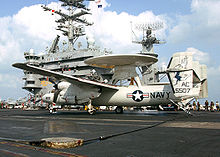 Ripples appear along the fuselage of a US Navy E-2C due to loads from landing on the USS Harry S. Truman (CVN-75)
Ripples appear along the fuselage of a US Navy E-2C due to loads from landing on the USS Harry S. Truman (CVN-75)
By 1965 the major development problems delaying the E-2A Hawkeye got so bad that the aircraft was actually cancelled after 59 aircraft had already been built. Particular difficulties were being experienced due to inadequate cooling in the closely packed avionics compartment. Early computer and complex avionics systems generated considerable heat; without proper ventilation this would lead to system failures. These failures continued long after the aircraft entered service and at one point reliability was so bad the entire fleet of aircraft was grounded. The airframe was also prone to corrosion, a serious problem in a carrier based aircraft.
After Navy officials had been forced to explain to Congress why four production contracts had been signed before avionics testing had been completed, action was taken; Grumman and the US Navy scrambled to improve the design. The unreliable rotary drum computer was replaced by a Litton L-304 digital computer and various avionic systems were replaced – the upgraded aircraft were designated E-2Bs. In total, 49 of the 59 E-2As were upgraded to E-2B standard. These aircraft replaced the E-1B Tracers in the various US Navy AEW squadrons and it was the E-2B that was to set a new standard for carrier based AEW aircraft.
E-2C Hawkeye and developments
Although the upgraded E-2B was a vast improvement on the unreliable E-2A, it was an interim measure. The US Navy knew the design had much greater capability and had yet to achieve the performance and reliability parameters set out in the original 1957 design. In April 1968 a reliability improvement program was instigated. In addition, now that the capabilities of the aircraft were starting to be realized, more were desired;28 new E-2Cs were ordered to augment the 49 E-2Bs that would be upgraded. Improvements in the new and upgraded aircraft were concentrated in the radar and computer performance.
Two E-2A test machines were modified as prototypes of the E-2C, with the first flying on 20 January 1971. Trials proved satisfactory and the E-2C was ordered into production, with the first production machine performing its initial flight on 23 September 1972. The original E-2C, known as Group 0, consisted of 55 aircraft with the first aircraft becoming operational in 1973. They began arriving on carriers in the 1980s, serving until the 1990s when they were replaced by Group II aircraft in first-line service. Some some ended up in the US Navy Reserve, being used to track drug smugglers.
After the experience with the E-2A/B, the E-2C Group 0 was an outstanding aircraft in operation and provided an effective partner to Grumman F-14 Tomcat fighters; monitoring the airspace and then vectoring Tomcats over the Link-4 datalink to destroy potential threat with long range Phoenix air-to-air missiles.
The next production run, between 1988 and 1991, saw 18 aircraft built to the Group I standard. Group I aircraft replaced the E-2's older APS-125 radar and T56-A-425 turboprops with their improvements; the APS-139 radar system and T56-A-427 turboprops. The first Group I aircraft entered service on August 1981. Upgrading the Group 0 aircraft to Group 1 specifications was considered, but the cost was comparable to a new production aircraft, so upgrades were not conducted. Group 1 aircraft were only only flown by the Atlantic fleet squadrons. This version of the E-2 was followed within a few years by the more-improved Group II, which had the improved APS-145 radar. Group II aircraft have been incrementally upgraded with new navigation systems, better situational display, and computerized electronics; culminating in the E-2C Hawkeye 2000 variant (sometimes called the Group III). A total of 50 Group II aircraft were delivered, 12 being upgraded Group I aircraft. This new version entered service in June 1992 and served with the Pacific and Atlantic Fleet squadrons.
By 1997 the US Navy intended that all the front line squadrons would be equipped, for a total of 75 Group II aircraft. However Grumman merged with Northrop in 1994 and plans began on the next upgrade, known as the Group II Plus, which eventually became known as the Hawkeye 2000. The Hawkeye 2000 featured the APS-145 radar with a new mission computer and CIC (Combat Information Center) workstations (Advanced Control Indicator Set or ACIS), and carries the U.S. Navy’s new CEC (cooperative engagement capability) data-link system. It is also fitted with a larger capacity vapor cycle avionics cooling system. A variant of the Group II with the upgrades to the mission computer and CIC workstations is referred to as the MCU/ACIS. All Group II aircraft have had their 1960s vintage computer-processors replaced by a mission computer with the same functionality but built using more modern computer technology. This is referred to as the GrIIM RePr (Group II Mission Computer Replacement Program, pronounced "grim reaper").
Starting in 2007 a hardware and software upgrade package began to be added to existing Hawkeye 2000 aircraft. This upgrade allows faster processing, double current trackfile capacity and access to satellite information networks. Hawkeye 2000 cockpits being upgraded include solid-state glass displays, modern weather detection systems and a GPS-approach capability.
E-2D Advanced Hawkeye
 External images
External imagesHi-res cutaway diagram 
Cutaway diagram of E-2D Advanced Hawkeye Though once considered for replacement by the "Common Support Aircraft", this conception never went into production, and the Hawkeye will continue in its role as the Navy's primary AEW aircraft for years into the future in the E-2D version.
The latest version of the E-2, the E-2D Advanced Hawkeye, is currently under development and the first two aircraft, "Delta One" and "Delta Two" remain in flight testing and several other aircraft are currently undergoing Initial Operational Test and Evaluation with Test and Evaluation Squadron One at [NAS Patuxent River]. The E-2D features an entirely new avionics suite, including the new APY-9 radar, radio suite, mission computer, integrated satellite communications capability, flight management system, improved T56-A-427A turboprop engines, a new tactical glass cockpit and the potential capability for air-to-air refueling. The APY-9 radar features an Active Electronically Scanned Array, which adds electronic scanning to the mechanical rotation of the radar in its radome. The E-2D will include provisions for either one of the pilots to act as a Tactical 4th Operator, who will have access to the full range of the mission's acquired data. The E-2D's first flight occurred on 3 August 2007.[5] On May 8, 2009, an E-2D Advanced Hawkeye used its Cooperative Engagement Capability system to engage an overland cruise missile with a Standard Missile SM-6 fired from another platform in an integrated fire-control system test.[6] Deliveries of initial production E-2Ds to Navy began in 2010.[7]
On 4 February 2001, Delta One conducted the first E-2D carrier landing aboard the USS Harry S. Truman CV-75. It is currently continuing carrier suitability testing. [8]
On 27 September 2011, an E-2D aircraft was successfully launched using the prototype Electromagnetic Aircraft Launch System (EMALS) at Naval Air Engineering Station Lakehurst.[9][10]
Design
The E-2 is a high-wing airplane, with one turboprop engine in each wing, and tricycle landing gear. As with all carrier-borne airplanes, the E-2 is equipped with a tail hook for landings, and it is capable of using the aircraft carrier's catapults for take-off. A distinguishing feature of the Hawkeye is its 24-foot (7.3 m) diameter rotating dome that is mounted above its fuselage and wings. This carries the E-2's primary antennas for its long-range radars. No other carrier-borne aircraft possesses one of these, and among land-based aircraft, they are mostly seen atop the Boeing's E-3 Sentry, a larger AEW airplane operated by the U.S. Air Force and NATO air forces in large numbers.
The aircraft is operated by a crew of five, with the pilot and co-pilot on the flight deck and the combat information center officer, air control officer and radar operator stations located in the rear fuselage directly beneath the rotodome.
In U.S. service, the E-2 Hawkeye provides all-weather airborne early warning and command and control capabilities for all aircraft-carrier battle groups. In addition, its other purposes include sea and land surveillance, the control of the aircraft carrier's fighter planes for air defense, the control of strike aircraft on offensive missions, the control of search and rescue missions for naval aviators and sailors lost at sea, and for the relay of radio communications, air-to-air and ship-to-air.
The E-2C and E-2D Hawkeyes use advanced electronic sensors combined with digital computerized signal processing especially its radars for early warning of enemy aircraft attacks and anti-ship missile attacks, and the control of the carrier's combat air patrol (CAP) fighters, and secondarily for surveillance of the surrounding sea and land for enemy warships and guided-missile launchers, and any other electronic surveillance missions as directed.
Operational history
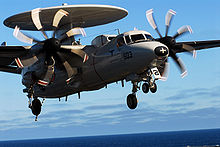 A US Navy E-2C of VAW-117 approaches to land on the flight deck of the USS John C. Stennis (CVN-74), clearly showing the new eight-bladed propellers installed on all of the Navy's E-2Cs
A US Navy E-2C of VAW-117 approaches to land on the flight deck of the USS John C. Stennis (CVN-74), clearly showing the new eight-bladed propellers installed on all of the Navy's E-2Cs
The E-2A entered U.S. Navy service on January 1964, and in April 1964 with VAW-11 at NAS North Island.[4] The first deployment was aboard the USS Kitty Hawk (CVA-63) during 1965.[11]
Since entering combat during the Vietnam War, the E-2 has served the US Navy around the world, acting as the electronic "eyes of the fleet". Hawkeyes from the air wing VAW-123 aboard the aircraft carrier USS America (CV-66) directed a group of F-14 Tomcat fighters flying the Combat Air Patrol during Operation El Dorado Canyon, the joint strike of two Carrier Battle Groups in the Mediterranean Sea against Libyan terrorist targets during 1986. More recently, E-2Cs provided the command and control for both aerial warfare and land-attack missions during the Persian Gulf War. Hawkeyes have supported the U.S. Coast Guard, the U.S. Customs Service, and American federal and state police forces during anti-drug operations.
In the mid-1980s, several E-2Cs were borrowed from the U.S. Navy and given to the U.S. Coast Guard and the U.S. Customs Service for counternarcotics (CN) and maritime interdiction operations (MIO). This also led to the Coast Guard building a small cadre of Naval Flight Officers (NFOs), starting with the recruitment and interservice transfer of Navy flight officers with E-2 flight experience and the flight training of other junior Coast Guard officers as NFOs. A fatal aircraft mishap on 24 August 1990 involving a Coast Guard E-2C at the former Naval Station Roosevelt Roads in Puerto Rico[12] prompted the Coast Guard to discontinue flying E-2Cs and to return its E-2Cs to the Navy. The U.S Customs Service also returned its E-2Cs to the Navy and concentrated on the use of former U.S. Navy P-3 Orion aircraft in the CN role.[citation needed]
E-2C Hawkeye squadrons played a critical role in air operations during Operation Desert Storm. In one instance, a Hawkeye crew provided critical air control direction to two F/A-18 Hornet aircrew, resulting in the shootdown of two Iraqi MiG-21s. During Operations Southern Watch and Desert Fox, Hawkeye crews continued to provide thousands of hours of air coverage, while providing air-to-air and air-to-ground command and control in a number of combat missions.[citation needed]
The E-2 Hawkeye is a crucial component of all U.S. Navy carrier air wings, and each carrier is equipped with four Hawkeyes (five in some situations), allowing for continuous 24-hour-a-day operation of at least one Hawkeye, and allowing for one or two of them to be undergoing maintenance in the aircraft carrier's hangar deck at all times. Until 2005 the US Navy Hawkeye’s were organised into East and West coast wings, supporting the respective fleets. However, the East coast wing was disestablished and all aircraft are now organised into a single wing based at Point Mugu, California. Six E-2C Hawkeye aircraft are deployed by the US Naval Reserve for drug interdiction and homeland security operations.
During Operation Enduring Freedom and Operation Iraqi Freedom all ten Regular Navy Hawkeye squadrons flew overland sorties. They provided battle management for attack of enemy ground targets, close-air-support coordination, combat search and rescue control, airspace management, as well as datalink and communication relay for both land and naval forces. During the aftermath of Hurricane Katrina, three Hawkeye squadrons (two Regular Navy and one Navy Reserve) were deployed in support of civilian relief efforts including Air Traffic Control responsibilities spanning three states, and the control of U.S. Army, U.S. Navy, U.S. Air Force, U.S. Marine Corps, U.S. Coast Guard, and Army National Guard and Air National Guard helicopter rescue units.
Hawkeye 2000s first deployed in 2003 aboard USS Nimitz (CVN-68) with VAW-117, the "Wallbangers", and CVW-11. U.S. Navy E-2C Hawkeyes have been upgraded with eight-bladed propellers as part of the NP2000 program; the first squadron to cruise with the new propellers was VAW-124 "Bear Aces". The Hawkeye 2000 version can track more than 2,000 targets simultaneously (while at the same time, detecting 20,000 simultaneously) to a range greater than 400 mi (640 km) and simultaneously guide 40–100 air to air intercepts or air to surface engagements.
VAW-120, the E-2C fleet replacement squadron began receiving E-2D Advanced Hawkeyes for training use in July 2010.[13] Initial operating capability for an E-2D fleet squadron ready for operational deployment has slipped to October 2014.[14]
Other operators
E-2 Hawkeyes have been sold by the U.S. Federal Government under Foreign Military Sales (FMS) procedures to the armed forces of Egypt, France, Israel, Japan, Singapore and Taiwan (in alphabetical order).[15]
 French Navy Hawkeye with folded wings
French Navy Hawkeye with folded wings
The French Naval Aviation (Aeronavale) operates three E-2C Hawkeyes and has been the only operator of the E-2 Hawkeye from an aircraft carrier besides the U.S. Navy.[16] The French nuclear-powered carrier, the Charles De Gaulle, currently carries two E-2C Hawkeyes on her combat patrols offshore. The three French E-2C Hawkeye have been upgraded with eight-bladed propellers as part of the NP2000 program. In April 2007, France requested the foreign military sale (FMS) of an additional aircraft.
The Flotille 4F of the French Navy's Aeronavale flies its E-2C Hawkeyes from its naval air station at Lann-Bihoue or the «Charles de Gaulle» aircraft carrier. They took part in operations in Afghanistan and Libya.
Japan Air Self-Defense Force
The Japan Air Self-Defense Force bought thirteen E-2C to improve its Early warning capabilities. The E-2C was put into service with the Airborne Early Warning Group (A.E.W.G.) at Misawa Air Base in January 1987.
On September 6, 1976, Soviet Air Force pilot Viktor Belenko successfully defected, landing his MiG-25 'Foxbat' at Hakodate Airport, Japan. During this incident, the Japan Self-Defense Forces' radar lost track of the aircraft when Belenko flew his MiG-25 at a low altitude, prompting the J.A.S.D.F to consider procurement of airborne early warning aircraft.
Initially, the E-3 Sentry airborne warning and control system aircraft was considered to be the prime candidate for the airborne early warning mission by the J.A.S.D.F. However, the Japanese Defense Agency realized that the E-3 would not be readily available due to U.S.A.F. needs and opted to procure E-2 Hawkeye AWACS aircraft.
Mexico
In 2004, three former Israel Air Force E-2C aircraft were sold to the Mexican Navy to perform maritime and shore surveillance missions. These aircraft were upgraded locally by IAI. The first Mexican E-2C was rolled out in January 2004.
Singapore
The Republic of Singapore Air Force acquired four Grumman E-2C Hawkeye airborne early warning aircraft in 1987, which are assigned to the 111 Squadron "Jaeger" based at Tengah Air Base. Its primary function is to perform airborne surveillance and early warning. Other functions include aircraft intercept control, surface surveillance, air traffic control and airborne coordination for search and rescue operations.
In April 2007, it was announced that the 4 E-2C Hawkeyes were to be replaced with 4 Gulfstream G550s which would become the primary early warning aircraft of the Singapore Air Force.[17]
Israel
Israel was the first export customer, its four Hawkeyes were delivered during 1981, complete with the folding wings characteristic of carrier borne aircraft. The four examples were soon put into active service before and during the 1982 Lebanon War during which they won a resounding victory over Syrian air defenses and fighter control. They were central to the Israeli victory in the air battles over the Bekaa Valley during which more than 90 Syrian fighters were downed. The Hawkeyes were also the linchpins of the operation in which the IAF destroyed the SAM array in the Bekaa, coordinating the various stages of the operation, vectoring planes into bombing runs and directing intercepts. Under the constant defense of F-15 Eagles, there were always two Hawkeyes on station off the Lebanese coast, controlling the various assets in the air and detecting any Syrian aircraft upon their takeoff, eliminating any chance of surprise.
The Israeli Air Force (IAF) operated four E-2s[16] for its homeland AEW protection through 1994. The IAF was the first user of the E-2 to install air-to-air refueling equipment.
Three of the four Israeli-owned Hawkeyes were sold to Mexico[16] in 2002 after they had been upgraded with new systems, and the remaining example was sent to be displayed in the Israeli Air Force Museum. In 2010, Singapore began retiring its E-2Cs as well. Both Israel and Singapore now employ the IAI Eitam, a Gulfstream G550-based platform utilizing Elta's EL/W-2085 sensor package (a newer derivative of the airborne Phalcon system) for their national AEW programmes.[18]
Taiwan
Taiwan acquired four Grumman E-2T aircraft from the US on 22 November 1995, which has extended the advance warning time of any attack from five to 25 minutes, bolstering Taiwan's limited protection against naval or air attack from mainland China. On 15 April 2006 Taiwan commissioned two new E-2K Hawkeye at an official ceremony at the Republic of China Air Force (ROCAF) base in Pingdong in southern Taiwan.
Egypt
Egypt purchased five E-2C Hawkeye, that entered service in 1987 the E-2C Hawkeye Airborne Early Warning (AEW) and were upgraded to Hawkeye 2000 standard. One additional upgraded E-2C was purchased. The first upgraded aircraft was delivered in March 2003 and deliveries were concluded in late 2008. Egypt requested two additional excess E-2C aircraft in October 2007, that were not sold. They all operate in 601 AEW Brigade, Cairo-West.
Offers
- In December 2007, the United Arab Emirates requested the sale of three upgraded E-2C aircraft.
- In August 2009, the U.S. Navy and Northrop Grumman briefed the Indian Navy on the E-2D Advanced Hawkeye. This covered potential use of this platform to satisfy its current shore-based and future carrier-based Airborne Early Warning and Control (AEW&C) requirements. The Indian Navy reportedly expressed interest in acquiring up to six Hawkeyes.[19][20][21]
Variants
 E-2A of VAW-11 landing in 1966 on the USS Coral Sea (CV-43)
E-2A of VAW-11 landing in 1966 on the USS Coral Sea (CV-43)
- W2F-1
- Original designation of the Hawkeye, changed to E-2A in 1962.
- E-2A
- Initial production version, was W2F-1 before 1962. 59 built.[11]
- TE-2A
- Two E-2As converted as crew trainers.[11]
- YC-2A
- Two E-2As, BUNOs 148147 and 148148, converted as prototypes of the C-2 Greyhound
- E-2B
- As E-2A but fitted with improved computing, enlarged outer fins. 52 converted from E-2A.[11]
- YE-2C
- Two E-2As, BUNOs 148712 and 148713, converted as E-2C prototypes. Designated as YE-2C and NE-2C respectively. These airframes then finished out their useful life being used as TE-2C pilot trainers.
- E-2C
- As the E-2B but with all new electronics, surveillance radar and search radar, 63 built. In "plus-models" the E-2C also has upgraded turboprop engines.
-
- E-2C Group 0
- Initial production version of E-2C, fitted with AN/APS-120 or AN/APS-125 radar. Lengthened nose compared to earlier versions[22][23]
- E-2C Group I
- New radar (AN/APS-139), plus ungraded mission computer and upgraded engines. 18 new build aircraft.[23][24]
- E-2C Group 2
- AN/APS-145 radar, further improved electronics.[23][24]
- E-2C Hawkeye 2000
- New mission computer, Cooperative Engagement Capability (CEC and additional satellite communications aerial. Originally designated Group 2+.[23][24]
- E-2D
- Currently undergoing flight testing and Initial Operational Test and Evaluation. This version will feature an entirely new avionics suite, improved engines, a new "glass cockpit" and the potential for air-to-air refueling.
- E-2T
- E-2C variant for Republic of China (Taiwan), with parts taken from retired E-2Bs (USN BuNos 151709, 151710, 151724, 152479) in order to please objections from the People's Republic of China and to make it appear as a sale of four rebuilt E-2As or E-2Bs. However, these aircraft have the same level of electronics as the E-2C Group II Hawkeyes with their APS-145 radars.[25][26][27]
Operators
- Egyptian Air Force has six E-2s, which were to be converted E-2 Hawkeye 2000 standard by the end of 2008.
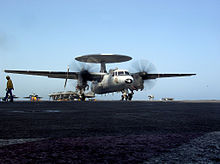 French Naval Aviation Hawkeye preparing to be catapulted from French aircraft carrier Charles De Gaulle.
French Naval Aviation Hawkeye preparing to be catapulted from French aircraft carrier Charles De Gaulle.
- French Naval Aviation fleet has three E-2 2000s, and is seeking a fourth.
- Israeli Air Force operated four Hawkeyes through 1999.
- 192 Squadron IDFAF
- Japan Air Self-Defense Force
- 601 Hikotai JASDF operates 13 E-2C Hawkeyes.
- Mexican Navy has three E-2C which were purchased from Israel.
- Republic of Singapore Air Force
- 111 Squadron operates four E-2Cs. They are currently in the process of being phased out with the newer Gulfstream G550 AEW as their replacement.[28]
- Republic of China Air Force has four E-2Ts and two E-2C Hawkeye 2000s. The four E-2Ts had been approved to be upgraded to Hawkeye 2000 configuration.[27][29][30]
- 2nd Early Warning Squadron ROCAF
- United States Navy
- VAW-77 Night Wolves (Navy Reserve Force Squadron)
- VAW-78 Fighting Escargot (Navy Reserve Force Squadron; disestablished)
- VAW-88 Cottonpickers (Navy Reserve Force Squadron; disestablished)
- VAW-110 Firebirds (Fleet Replacement Squadron - Pacific Fleet FRS; disestablished)
- VAW-111 Graybirds (Disestablished)
- VAW-112 Golden Hawks
- VAW-113 Black Eagles
- VAW-114 Hormel Hawgs (Disestablished, April 1995)
- VAW-115 Liberty Bells
- VAW-116 Sun Kings
- VAW-117 Wallbangers
- VAW-120 Greyhawks (Fleet Replacement Squadron)
- VAW-121 Bluetails
- VAW-122 Steeljaws (Disestablished)
- VAW-123 Screwtops
- VAW-124 Bear Aces
- VAW-125 Tigertails
- VAW-126 Seahawks
- VAW-127 Seabats (Disestablished)
- VX-20 Force Aircraft Test
- VX-1 Pioneers
- Carrier Airborne Early Warning Weapons School (CAEWWS; merged into NSAWC)
- Naval Strike and Air Warfare Center (NSAWC)
- U.S. Coast Guard
- CGAW-1[31] (Disestablished)
Aircraft on display
- E-2B, BuNo 150540, National Museum of Naval Aviation, NAS Pensacola, Florida[32]
- E-2B, BuNo 152476, Patuxent River Naval Air Museum, NAS Patuxent River, Maryland[32]
- E-2B, BuNo 152484, Air Victory Museum, Medford, New Jersey[32]
- E-2B, BuNo 150541, NAS Norfolk Air Park (adjacent Gate 4), Naval Station Norfolk/Chambers Field (former NAS Norfolk), Virginia. Early E-2C variant nose cap installed for static display.
- E-2C, BuNo 159496, Naval Air Station Fallon, Nevada.
- E-2C, BuNo 160012, Garden City, NY as part of Cradle of Naval Aviation Display
- E-2C, NuNo 160701, nose used as flight simulator aboard USS Midway Museum, San Diego, California
- E-2C, BuNo 160772,Israeli Air Force Museum, Hatzerim Air Base, Israel
- E-2C, BuNo 160992, on base memorial display,NAS Point Mugu, California
- E-2C, BuNo 161227, flight deck display aboard USS Midway (CV-41) Museum, San Diego, California[33]
- E-2C, BuNo 161098, on display at NAS Atlanta, GA
- E-2C, BuNo 161344, awaiting resoration at Yanks Air Museum, Chino, CA
Specifications (E-2C/D)
Data from US Navy fact file[34] E-2D_Storybook (page 25)[35]
General characteristics
- Crew: Five: two pilots, combat information center officer, the air control officer, and the radar operator
- Length: 57 ft 8.75 in (17.60 m)
- Wingspan: 80 ft 7 in (24.56 m)
- Height: 18 ft 3.75 in (5.58 m)
- Wing area: 700 ft²[36] (65 m²)
- Empty weight: 43,068 lb (19,536 kg)
- Loaded weight: 40,200 lb (18,090 kg)
- Max takeoff weight: 57,500 lb (26,083 kg)
- Powerplant: 2 × Allison / Rolls-Royce T56-A-427A turboprop, 5,100 shp (3,800 kW) each
Performance
- Maximum speed: 350 knots (648 km/h)
- Cruise speed: 256 knots (474 km/h)
- Ferry range: 1,462 nmi (2,708 km)
- Endurance: 6 hr
- Service ceiling: 34,700 ft (10,576 m)
- Wing loading: 72.7 lb/ft² (355 kg/m²)
- Power/mass: 0.19 hp/lb (0.32 kW/kg)
See also
- Related development
- Aircraft of comparable role, configuration and era
References
- Notes
- ^ Koppmann, George C., Carrier Airborne Early Warning. George C. Koppmann (LT, USNR - inactive) home page. [1] Retrieved: 13 December 2006.
- ^ Godfrey 1977, pp. 7–8.
- ^ a b Taylor 1976, p. 291.
- ^ "Northrop Grumman E-2D Advanced Hawkeye Completes First Flight". Northrop Grumman, 3 August 2007.
- ^ Integrated Live-Fire Test Demonstrates Future Weapons System Capability
- ^ "Northrop Grumman's E-2D Advanced Hawkeye Program Demonstrating Continued Success". Northrop Grumman, 9 December 2009.
- ^ [2]
- ^ "Navy's new electromagnetic catapult 'real smooth'". Newbury Park Press. September 28, 2011. http://www.app.com/article/20110927/NJNEWS/309270121/Navy-s-new-electromagnetic-catapult-real-smooth-. Retrieved 2011-10-04.
- ^ "New carrier launch system tested". Security Industry. UPI. October 3, 2011. http://www.upi.com/Business_News/Security-Industry/2011/10/03/New-carrier-launch-system-tested/UPI-13601317652464/. Retrieved 2011-10-04.
- ^ a b c d Godfrey 1977, p.8.
- ^ U.S. Coast Guard Aviation Casualties
- ^ [|Wiltrout, Kate] (30 July 2010), "Navy welcomes Advanced Hawkeye, newest eye in the sky", The Virginian-Pilot, http://hamptonroads.com/2010/07/navy-welcomes-advanced-hawkeye-newest-eye-sky
- ^ GAO-10-388SP, Defense Acquisitions: Assessments of Selected Weapon Programs, March 30, 2010
- ^ Donald, David, ed. "Grumman E-2 Hawkeye/TE-2/C-2 Greyhound". The Complete Encyclopedia of World Aircraft. Barnes & Nobel Books, 1997. ISBN 0-7607-0592-5.
- ^ a b c Eden, Paul, ed. "Northrop Grumman E-2 Hawkeye, Eyes of the fleet". Encyclopedia of Modern Military Aircraft. Amber Books, 2004. ISBN 1-904687-84-9.
- ^ "Planned replacement for AEW E-2C" (Press release). Singaporean Ministry of Defence (MINDEF). 23 April 2007. http://www.mindef.gov.sg/imindef/news_and_events/nr/2007/apr/23apr07_nr/23apr07_fs3.html. Retrieved 13 June 2011.
- ^ Egozi, Arie (23 March 2010). "Israeli air force showcases G550 surveillance fleet". Flight International. http://www.flightglobal.com/articles/2010/03/23/339637/israeli-air-force-showcases-g550-surveillance-fleet.html. Retrieved 2010-08-06.
- ^ Indian Navy Mulls Northrop Advanced Hawkeye
- ^ Indian Navy Pursues Fixed-Wing Carrier AEW
- ^ "US clears Hawkeye E-2D aircraft for India"[dead link]. Times of India, 14 September 2009.
- ^ Godfrey 1977, pp. 9–10.
- ^ a b c d Jackson 2003, p. 687.
- ^ a b c Winchester Air International December 2005, p. 47.
- ^ Taiwan Air Power E-2C/T page
- ^ "US Navy/Marine Corps BuNos Third Series (150139 to 156169)". Joe Baugher (JoeBaugher.Com). Last revised 24 July 2010. http://www.joebaugher.com/navy_serials/thirdseries19.html. Retrieved 4 October 2010.
- ^ a b E-2 Hawkeye
- ^ "RSAF's First Gulfstream 550 Airborne Early Warning Aircraft Returns to Singapore" (Press release). Ministry of Defence (Singapore). 19 February 2009. http://www.mindef.gov.sg/imindef/news_and_events/nr/2009/feb/19feb09_nr.html. Retrieved 4 October 2010.
- ^ Taiwan Air Power E-2T page
- ^ Defense Security Cooperation Agency News Release. October 3, 2008, retrieved Sept. 14, 2009
- ^ CGAW-1 and Airfac Norfolk article
- ^ a b c http://www.aero-web.org/locator/manufact/grumman/e-2.htm
- ^ http://www.midwaysaircraft.org/acft/E2C.htm
- ^ The US Navy - Fact File: E-2 Hawkeye early warning and control aircraft
- ^ http://www.as.northropgrumman.com/products/e2dhawkeye/assets/E-2D_Storybook.pdf
- ^ Jackson 2003, pp. 688–689.
- Bibliography
- Donald, David, ed. "E-2 Hawkeye". Warplanes of the Fleet. AIRtime, 2004. ISBN 1-880588-81-1.
- Eden, Paul, ed. The Encyclopedia of Modern Military Aircraft. London: Amber Books, 2004. ISBN 1-904687-84-9.
- Godfrey, David W. H. "Hawkeye:A New Dimension in Tactical Warfare". Air International, January 1977, Vol 12 No 1. Bromley, UK:Fine Scroll. pp. 7–13, 42–44.
- Jackson, Mark. Jane's All The World's Aircraft 2003–2004. Coulsdon, UK: Jane's Information Group, 2003. ISBN 0 7106 2537 5.
- Neubeck, Ken. E-2 Hawkeye Walk Around. Squadron/Signal Publications, 2008. ISBN 0-89747-555-0.
- Swanborough, Gordon and Peter M. Bowers. United States Navy Aircraft since 1911. London:Putnam, Second edition, 1976. ISBN 0 370 10054 9.
- Taylor, John W. R. Jane's All The World's Aircraft 1976–77. London:Jane's Yearbooks, 1976. ISBN 0 354 00538 3.
- Winchester, Jim. "E-2 Hawkeye Developments". Air International, December 2005, Vol 69 No 6. Stamford, UK:Key Publishing. pp. 46–49.
- Winchester, Jim, ed. Military Aircraft of the Cold War (The Aviation Factfile). London: Grange Books plc, 2006. ISBN 1-84013-929-3.
External links
- E-2 fact file and E-2C Hawkeye history page on US Navy site
- E-2 page on GlobalSecurity.org
- E-2D Hawkeye: The Navy’s New AWACS on Defense Industry Daily
- "Advanced Hawkeye promises quantum leap in US Navy's AEW capability"[dead link], Jane's, 30 June 2006.[dead link]
- "Northrop Grumman E-2D Advanced Hawkeye Completes First Flight", Northrop Grumman, 3 August 2007
- Marine nationale - Hawkeye on Alabordache.fr[dead link] (French)
- Gallery of photographs of the French E-2C Hawkeye on NetMarine.net (French)
- Taiwan Air Power E-2T page
Grumman and Northrop Grumman aircraft Manufacturer
designationsG-1 (floats only) · G-2 (floats only) · G-3 · G-4 · G-5 · G-6 · G-7 · G-8 · G-9 · G-10 · G-11 · G-12 · G-13 · G-14 · G-15 · G-16 · G-17 · G-18 · G-19 · G-20 · G-21 · G-22 · G-23 · G-24 · G-25 · G-26 · G-27 · G-29 · G-30 · G-31 · G-32 · G-33 · G-34 · G-35 · G-36 · G-37 · G-38 · G-39 · G-40 · G-41 · G-42 · G-43 · G-44 · G-45 · G-46 · G-47 · G-48 · G-49 · G-50 · G-51 · G-52 · G-53 · G-54 · G-55 · G-56 · G-57 · G-58 · G-59 · G-60 · G-61 · G-62 · G-63 · G-64 · G-65 · G-66 · G-67 · G-68 · G-69 · G-70 · G-71 · G-72 · G-73 · G-74 · G-75 · G-76 · G-77 · G-78 · G-79 · G-80 · G-81 · G-82 · G-83 · G-84 · G-85 · G-86 · G-87 · G-88 · G-89 · G-90 · G-91 · G-92 · G-93 · G-94 · G-96 · G-97 · G-98 · G-98J · G-99 · G-100 · G-101 · G-102 · G-103 · G-104 · G-105 · G-106 · G-107 · G-108 · G-109 · G-110 · G-111 · G-112 · G-113 · G-114 · G-115 · G-116 · G-117 · G-118 · G-119 · G-120 · G-121 · G-122 · G-123 · G-124 · G-125 · G-126 · G-127 · G-128 · G-134 · G-159 · G-164 · G-191 · G-231 · G-234 · G-251 · G-262 · G-303 · G-426 · G-712 · G-1128 · G-1159
By role Piston fightersJet fightersF9F · F9F/F-9 · XF10F · F11F/F-11/F11F-1F · G-118 · F-111B · F-14
Attack/PatrolRecon/ScoutsUtility/TransportsCivil aircraftMallard · Ag Cat · Kitten · Tadpole · Gulfstream I · Gulfstream II
OthersApollo Lunar Module · EF-111 · X-29 · Q-8 · X-47A · X-47B
By name Ag Cat · Albatross · Avenger · Bearcat · Cougar · Duck · Fifi · Goose · Greyhound · Guardian · Gulfhawk III · Gulfstream I · Gulfstream II · Hawkeye · Hellcat · Intruder · Jaguar · Kitten · Mallard · Mohawk · Panther · Pegasus · Prowler · Skyrocket · Super Tiger · Tadpole · Tiger · Tigercat · Tomcat · Tracer · Tracker · Trader · Wildcat · Widgeon
USN AEW aircraft designations pre-1962 Grumman WF • W2F
Vought XWU
Lockheed WV
United States tri-service EW aircraft designations post-1962 Lists relating to aviation General Aircraft (manufacturers) · Aircraft engines (manufacturers) · Airlines (defunct) · Airports · Civil authorities · Museums · Registration prefixes · Rotorcraft (manufacturers) · TimelineMilitary Accidents/incidents Records Categories:- Grumman aircraft
- Carrier-based aircraft
- AWACS aircraft
- Gulf War aircraft
- United States military reconnaissance aircraft 1960–1969
Wikimedia Foundation. 2010.

